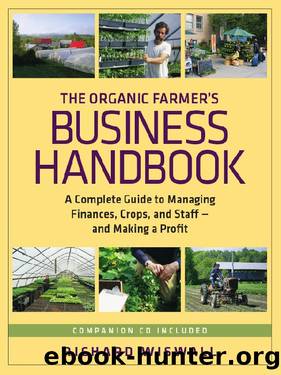The Organic Farmer's Business Handbook: A Complete Guide to Managing Finances, Crops, and Staff - and Making a Profit by Richard Wiswall

Author:Richard Wiswall [Wiswall, Richard]
Language: eng
Format: epub, pdf
Publisher: Chelsea Green Publishing
Published: 2009-10-09T00:00:00+00:00
Paid bills in chronological order.
A few variations on this simple paid bills/ unpaid bills setup warrant discussion. Some are commonplace, like using personal checks or cash to pay for farm expenses. Others will increase office efficiency, such as paying by credit card or setting up monthly statements.
Using Cash
If Iâm delivering produce in town and running on empty, but I forgot my checkbook, I may pay cash for some fuel to get home. Because the delivery fuel is a bona fide farm cost, I want to make sure I expense it through the farm account to take advantage of the substantial tax benefit. Chapter 8 explores this topic in detail, but, in short, if I fail to record a farm expense, I personally lose one-third of the purchase price.
Say what? If I spend $45 on delivery fuel and forget to record it as a farm cost for tax purposes, I donât get to offset my farm income with that $45. My year-end profit would be $45 higher, and Iâm going to have to pay taxes on that extra $45. Taxes for the self-employed cut a full third out of year-end profit (usually 15 percent federal income tax, 15.3 percent Social Security and Medicare, and roughly 4 percent state income tax). So thatâs an extra $15 I would have to pay in taxes just because I didnât record my $45 in fuel as a farm expense. Every farm expense should be used to offset your farm income and profit to save overpaying taxes.
This example shows that Iâm actually $15 poorer by not recording the $45 of fuel (paid by cash, or any other means) as a farm expense. Fifteen dollars may not seem like a lot, but over the course of a year, all missed expenses add upâand come right out of your wallet.
The lesson: Record all your farm expenses, cash or not.
What do I do when I pay cash for a farm item? I write on the slip âpaid cashâ and put it into the unpaid bills area in my office. I pay that bill from farm funds as I would any other unpaid bill, the only difference being that I make the farm check out to myselfâreimbursing my personal funds. I mark on the bill âreimbursement for ____, paid check # ___,â add the date, and circle the dollar amount.
Set Up Accounts Billed Monthly
Another variation on the basic paid bills/ unpaid bills setup is one that increases efficiency and reduces errors: setting up expense accounts with monthly statements for all the businesses you routinely purchase from. Hardware stores, auto parts outlets, feed suppliers, seed companies, and gas stations are all likely candidates. Instead of writing a check every time you purchase gasoline, or some nuts and bolts, or a packet of seed, let the business you buy from keep a tab going for you, and then pay by monthly statement. Youâll never write more than twelve checks per year for each business, and youâll be writing them at the calm of your office deskânot rushing off to finish deliveries or bolt up your irrigation pump.
Download
The Organic Farmer's Business Handbook: A Complete Guide to Managing Finances, Crops, and Staff - and Making a Profit by Richard Wiswall.pdf
This site does not store any files on its server. We only index and link to content provided by other sites. Please contact the content providers to delete copyright contents if any and email us, we'll remove relevant links or contents immediately.
| Automotive | Engineering |
| Transportation |
Whiskies Galore by Ian Buxton(40334)
Introduction to Aircraft Design (Cambridge Aerospace Series) by John P. Fielding(32338)
Small Unmanned Fixed-wing Aircraft Design by Andrew J. Keane Andras Sobester James P. Scanlan & András Sóbester & James P. Scanlan(32141)
Craft Beer for the Homebrewer by Michael Agnew(17447)
Turbulence by E. J. Noyes(7041)
The Complete Stick Figure Physics Tutorials by Allen Sarah(6640)
Kaplan MCAT General Chemistry Review by Kaplan(6054)
The Thirst by Nesbo Jo(5786)
Bad Blood by John Carreyrou(5770)
Learning SQL by Alan Beaulieu(5412)
Weapons of Math Destruction by Cathy O'Neil(5038)
Man-made Catastrophes and Risk Information Concealment by Dmitry Chernov & Didier Sornette(4738)
iGen by Jean M. Twenge(4702)
Digital Minimalism by Cal Newport;(4545)
Life 3.0: Being Human in the Age of Artificial Intelligence by Tegmark Max(4509)
Audition by Ryu Murakami(4099)
1,001 ASVAB Practice Questions For Dummies by Powers Rod(4040)
Electronic Devices & Circuits by Jacob Millman & Christos C. Halkias(4029)
Pale Blue Dot by Carl Sagan(4003)
